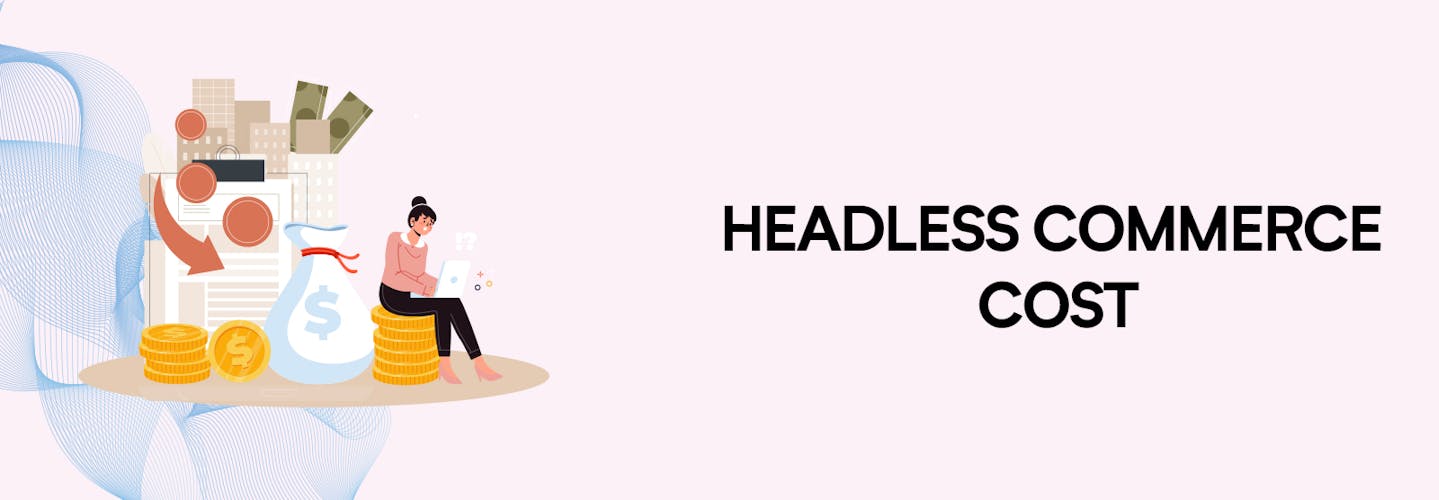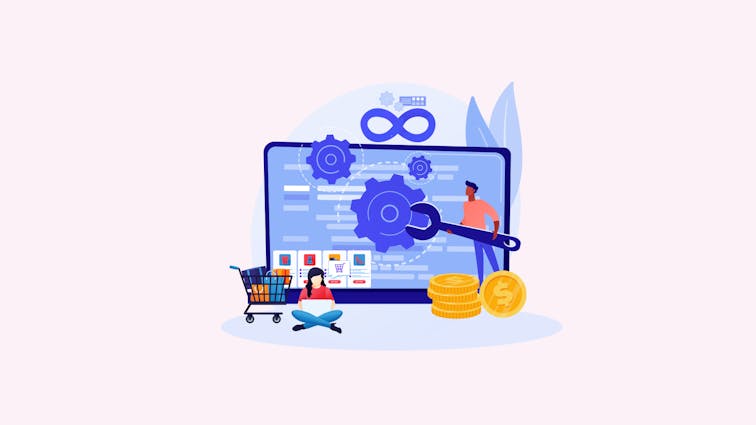
The Real Costs of Headless Commerce: A Eye-opening Overview
Have you ever stumbled upon the term ”headless commerce” and wondered what it’s all about?
Or perhaps you’re considering implementing it in your business but are concerned about the costs?
Well, you’ve come to the right place!
In this article, we’ll dive into the nitty-gritty of headless commerce, understand its importance, and weigh the costs of implementing it.
So, let’s get started, shall we?
What is Headless Commerce?
First things first, let’s break down what headless commerce actually is.
In simple terms, headless commerce is a separation of the front end and back end of an e-commerce application.
This allows you to work on the visual and user experience aspects separately from the core commerce functions.
Think of it as the decoupling of the ‘head’ (the front end, or the website) from the ‘body’ (the back end, or the commerce functionality).
But wait, what does this mean in practice?
Well, it means that you can make changes to your website’s layout, design, or content without affecting the shopping cart, payment processing, or inventory management systems.
Pretty neat, huh?
Headless Commerce vs. Traditional Commerce
Now, let’s talk about how headless architecture differs from traditional commerce.
In traditional commerce, the front end and back end are tightly coupled. This means that changes in one can affect the other.
For example, updating the look of your website might require changes to the back-end code, which can be time-consuming and costly.
On the other hand, with headless commerce, the front end and back end are independent.
This allows for more flexibility and agility in making changes to the website without affecting the core commerce functions. It’s like having your cake and eating it too!
The Benefits of Headless Commerce
So, why should you consider headless approach? Here are a few compelling reasons:
- Flexibility: As we mentioned earlier, the decoupling of the front and back ends allows for greater flexibility in design and functionality.
- Speed: Changes can be made more quickly without the need for extensive back-end alterations.
- Customization: You can create a unique user experience tailored to your audience.
- Scalability: Headless commerce can easily adapt to increased traffic or expanded product lines without compromising performance.
Read More: The Future of Ecommerce: Exploring the Benefits of Headless Commerce
The Cost of Headless Commerce

Factors Influencing the Cost of Headless Commerce
Now that we’ve covered what headless commerce is and its benefits, let’s delve into the cost aspect.
You might be wondering, “How much is this going to set me back?” Well, the cost of implementing headless commerce can vary greatly depending on several factors:
- Platform Selection: The choice of platform can significantly influence the cost. Some Headless platforms may offer more features but come with a higher price tag. It’s essential to choose a platform that fits your budget and meets your specific needs.
- Customization: The level of customization you want for your website can also affect the cost. More complex customizations may require more development time and thus increase the cost.
- Integration: Integrating the front-end and back-end systems can be a complex process, especially if you’re dealing with legacy systems. The cost of integration can vary depending on the complexity of your systems.
- Maintenance: Don’t forget about the ongoing costs of maintaining your website. This includes updates, security, and troubleshooting. These costs can add up over time, so it’s important to factor them into your budget.
Headless Commerce Cost vs. Traditional Commerce Cost
Comparing the cost of headless commerce with traditional commerce is not a straightforward apples-to-apples comparison.
Why? Because the two models offer different benefits and challenges.
Traditional commerce platforms often come with lower upfront costs. They’re typically easier to set up and manage, which can be a plus for businesses with limited resources or technical expertise.
However, they may not offer the same level of flexibility and scalability as headless commerce. Over time, the costs of updating and customizing a traditional commerce platform can add up.
On the other hand, headless commerce may require a larger initial investment, especially if you’re starting from scratch. The costs of development, customization, and integration can be higher.
However, the flexibility and scalability that headless commerce offers can lead to cost savings in the long run. You can quickly adapt to changes in the market or customer behavior, which can give you a competitive edge.
Costs Involved in Implementing Headless Commerce

Implementing headless commerce involves various costs, from setting up the infrastructure to ongoing website maintenance.
Let’s break down these costs to help you understand what you’re signing up for when you decide to go headless.
1. Infrastructure Costs
A. Purchase of Essential Facilities
The first step in implementing headless commerce is setting up the necessary infrastructure.
This includes purchasing the required hardware and software, such as servers, databases, and the headless commerce platform itself.
The cost can vary widely depending on the scale of your operations and the specific solutions you choose.
Below is a typical headless commerce architecture:
- Aasaan eCommerce back end: contact sales [Ecommerce platforms]
- Storyblok Headless CMS: $99/month
- Vercel Deployment: $60/month
- GitHub Code management: $20/month
B. Setting Up the Infrastructure
Once you’ve purchased the necessary facilities, you’ll need to set them up.
This involves configuring your servers, setting up your databases, and installing and setting up your headless commerce platform.
Depending on the complexity of your setup, you may need to hire IT professionals to handle this, which can add to the cost.
2. Set Up and Implementation Costs
A. Setting Up of Selected Platforms
After setting up your infrastructure, you’ll need to set up the platforms you’ve chosen for your headless commerce system.
This includes configuring the platforms to work with your infrastructure and customizing them to meet your specific needs.
B. Creating Individual Interfaces for Platforms
In a headless commerce system, you’ll need to create individual interfaces for each platform you use.
This could include different interfaces for desktop, mobile, and other devices. The cost of this will depend on the number of interfaces you need and the complexity of their design.
C. Gaining Support for APIs and Microservices
Headless commerce relies heavily on APIs and microservices to connect the front end and back end of your system.
You’ll need to ensure that your system supports these technologies, which may involve purchasing additional software or hiring professionals with expertise in these areas.
3. Development Costs
A. Hiring of Necessary Technical Teams
Implementing headless commerce can be technically complex, and you’ll likely need to hire a technical team to handle the development.
This could include web developers, database administrators, and IT professionals. The cost of hiring these teams can be significant, but it’s a necessary investment to ensure your system is set up correctly and runs smoothly.
B. Integration of Systems, Actions, and Controls
Once your team is in place, they’ll need to integrate your systems, actions, and controls.
This involves connecting your front end and back end systems, setting up your commerce functions, and ensuring that everything works together seamlessly.
The cost of this will depend on the complexity of your system and the amount of integration required.
C. Time Invested in Setting Up and Development
Don’t forget to factor in the time cost of setting up and developing your headless commerce system.
This includes the time spent by your team on planning, development, testing, and troubleshooting.
While it’s not a direct financial cost, it’s an important consideration as it can impact your team’s productivity and your time to market.
4. Ongoing Website Maintenance Costs
A. Regular Updates
Once your headless commerce system is up and running, you’ll need to keep it updated.
This includes updating your platform and any third-party solutions you use, as well as updating your website content.
Regular updates are crucial to ensure your system remains secure and functions correctly.
B. Security Measures
Security is a critical aspect of any e-commerce system. You’ll need to invest in security measures to protect your system and your customers’ data.
This could include purchasing security software, hiring a security consultant, or training your team in security best practices.
C. Ensuring Good Speeds and Easy Navigation
A good user experience is key to the success of your e-commerce site. You’ll need to ensure your site loads quickly and is easy to navigate.
This might involve investing in performance optimization, user experience design, and regular testing and troubleshooting.
5. Costs of Data and Content Management
A. Content Delivery Networks
To ensure fast load times and a smooth user experience, you might need to use a content delivery network (CDN).
A CDN is a network of servers that deliver your website content to users based on their geographic location.
The cost of a CDN can vary depending on the scale of your operations and the specific provider you choose.
B. Data Storage Solutions
Storing and managing your website data is another cost to consider. You’ll need a reliable data storage solution to handle your product information, customer data, and other essential data.
The cost of data storage can depend on the amount of data you need to store and the specific solution you choose.
C. Multi-Site Management
If you operate in multiple markets or have different websites for different parts of your business, you’ll need to manage multiple sites.
This can add to the complexity and cost of your headless commerce system. However, the flexibility of headless commerce can make multi-site management easier and more efficient.
Is Headless Commerce Worth the Cost?
So, we’ve talked about the costs associated with headless commerce, but the big question remains: Is it worth it?
Let’s take a closer look at the return on investment (ROI) for headless commerce and how it can be a cost-effective solution for businesses.
1. Return on Investment for Headless Commerce
The ROI for headless commerce can be significant. By providing a better user experience, you can increase conversion rates and customer loyalty.
The flexibility of headless commerce also allows you to quickly adapt to changes in the market or customer behavior, which can lead to increased sales.
Plus, the scalability of headless commerce means that your platform can grow with your business, potentially leading to long-term cost savings.
2. Long-Term Cost Benefits of Headless Commerce
While the upfront costs of headless commerce can be higher than traditional commerce, the long-term benefits can outweigh these initial investments.
The flexibility and scalability of headless commerce can lead to cost savings in the long run.
You can quickly adapt to changes in the market or customer behavior, which can give you a competitive edge.
Plus, the improved user experience can lead to increased sales and customer loyalty.
3. Headless Commerce as a Cost-Effective Solution
Headless commerce can be a cost-effective solution for businesses. By decoupling the front end and back end, you can make changes to your website without affecting the core commerce functions.
This can save you time and money in development costs. Plus, the improved user experience can lead to increased sales and customer loyalty.

How to Cut Headless Commerce Costs
Implementing headless commerce doesn’t have to break the bank. Here are some strategies for reducing the cost:
1. Leverage Frontend as a Service (FEaaS)
Frontend as a Service (FEaaS) is a development approach that can help reduce the cost of implementing headless commerce.
With FEaaS, you can leverage a pre-built front end that can be easily customized to fit your needs. This can save you time and money in development costs.
2. Start with the Frontend
When transitioning to headless commerce, consider starting with the frontend.
This allows you to improve the user experience and start seeing the benefits of headless commerce without a full overhaul of your system.
As your business grows and your needs evolve, you can gradually decouple the back end.
3. Start Small and Scale Up
You don’t have to do everything at once. Start with a small project or a single aspect of your business and scale up as you see success and as your budget allows.
This can make the transition to headless commerce more manageable and less risky.
4. Choose the Right Platform
The choice of platform can significantly impact your costs. Some platforms may offer more features but come with a higher price tag.
It’s essential to choose a platform that fits your budget and meets your specific needs. Do your research, compare different platforms, and consider both the upfront costs and the long-term value each platform offers.
5. Leverage Existing Resources
If you have an in-house IT team, leverage their skills and expertise. While you may need to invest in training to bring them up to speed on headless commerce, this can be more cost-effective than hiring external consultants or developers.
Conclusion:
Headless Commerce is not just a trend—it’s a valuable approach to e-commerce that can boost the efficiency and flexibility of your operation.
Despite the initial costs, the long-term value gained by enhancing user experience, adaptability to market changes, and simplified management of multiple sites can greatly outweigh these expenses.
Moreover, there are several ways to minimize costs while adopting this powerful medium— small-scale starting, selecting an appropriate platform, making use of existing resources, are to name a few.
End of the day, the pivot towards Headless Commerce is a strategic decision that can empower your business, has the potential to significantly improve your ROI and position you competitively in the market landscape.
FAQ’s:
1. What is the cost of headless commerce?
The cost of headless commerce can vary significantly based on the individual needs of each business. Factors affecting the cost include the platform chosen for commerce, the cost of data storage and management, the complexity of implementation, and the number of websites or markets that need to managed.
2.Why choose headless commerce despite its costs?
Despite potentially higher upfront costs, the long-term benefits of adopting headless commerce can outweigh the initial investment. Headless commerce provides greater flexibility and scalability for the business, which can lead to cost savings in the long run as well as increased conversion rates and customer loyalty due to improved user experience.
3. Why is headless so expensive?
Headless commerce can be more expensive due to its complexity and the need for specialized development expertise. The decoupling of the front-end and back-end requires additional infrastructure, integration efforts, and ongoing maintenance, leading to higher costs compared to traditional e-commerce solutions.
4. How much does headless commerce cost?
The cost of headless commerce varies depending on various factors such as the complexity of the project, desired features, scalability needs, and the chosen technology stack. Generally, headless implementations can range from tens of thousands to hundreds of thousands of dollars or more, including development, integration, hosting, and ongoing maintenance costs.
5. Why is headless commerce faster?
Headless commerce is faster because it separates the presentation layer (front-end) from the commerce functionality (back-end). This decoupling allows for optimized performance and faster loading times. With headless, developers can leverage lightweight front-end frameworks and optimize content delivery, resulting in improved website speed and better user experience.
6. Why is headless commerce the future?
Headless commerce is considered the future of e-commerce because it offers flexibility, scalability, and enhanced customer experiences. It allows businesses to deliver content and commerce across various channels, including web, mobile, IoT devices, and more. The decoupled architecture enables rapid innovation, easy integrations with third-party services, and personalized experiences, making it a compelling choice for forward-thinking businesses.
7. What are the costs for an e-commerce store?
The costs for an e-commerce store can vary significantly depending on factors like the platform chosen, the size of the store, desired features, design complexity, marketing expenses, and ongoing maintenance. Small-scale e-commerce solutions can cost a few hundred to a few thousand dollars, while larger enterprise-level stores can incur costs ranging from tens of thousands to millions of dollars annually.








